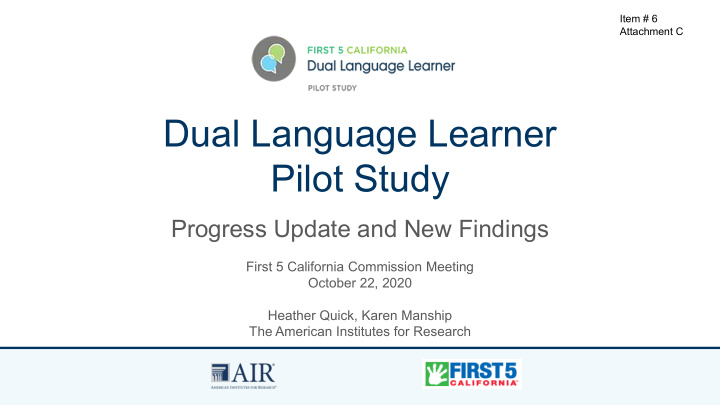



Item # 6 Attachment C Dual Language Learner Pilot Study Progress Update and New Findings First 5 California Commission Meeting October 22, 2020 Heather Quick, Karen Manship The American Institutes for Research
Dual Language Learner r Pi Pilot Study Ph Phases s Landscape/Background In-Depth Study : In Expansion Study: Study: Completed progress Launching soon
Addressing the I In-De Depth h Stud udy Q Questions s What strategies for • Program staff reports on classroom practices, PD, family instruction , professional engagement: development (PD), and ‒ Site administrator survey (as planned) family engagement are used for dual language ‒ Educator survey (as planned) learners (DLLs)? • Child outcomes (one point in time) : ‒ Preschool: Language skills, executive function, pre-academic skills ‒ Infant/toddler: Language and overall development What practices support • Child outcomes (two points in time as planned): positive outcomes for DLLs and their families? ‒ All: Social-emotional development • Family engagement: ‒ Parent survey (two points in time as planned)
In In-De Depth h Study: Plann nned Research Briefs s • Quick Facts: The Landscape of Early Learning and Care for DLLs – Just released • DLL Teachers’ Professional Development – Late October 2020 • Sites’ General Approaches to Supporting DLLs – November 2020 • Challenges in Multilingual Child Assessment – December 2020 • What We Can Learn from Assessing Math in Two Languages – January 2021 • 4–6 additional research briefs in 2021: − Relationship between teacher practices (instruction, family engagement) and child and family outcomes • Final report • Final summary research brief in English, Spanish, Chinese
Ear arly L Lear arning an g and Car are P Progr ogram ams Ser erving D DLLs: P Pre-COVID a and nd No Now w Findings just released in the study’s first Quick Facts brief
Finding: Nearl rly Al All Centers a and M Most Family Child Care Homes in Californ rnia Serve DLLs s Centers Family Child Care Homes
Finding: The C Concentration of DLLs in Early Le Learning Programs Varies Widely y Family Child Care Homes Centers The average early learning program serving DLLs enrolls 53% DLLs.
Fi Finding: Multi tilingual Sites Are Common n Number of Languages in ELC Programs
Finding: M More T e Than an On One Q e Quart arter er o of DLL-Ser erving Progr grams U Use O Only E Engl glish f for Instructi tion
Challenges Directors R Report rt in Serving DLLs
Few Requirements for r DLL-Focused P PD D • Directors of most programs reported that their staff were not required to participate in PD specifically focused on DLLs. − This varied by QCC participation and program funding. • More details on professional development will be presented in the next research brief (early November 2020).
Impact of COVID ID-19 19 on D DLLs • Supplemental survey of a representative sample of early learning programs about COVID. • Programs reported facing significant financial challenges: − 68% reported that their programs’ financial stability represented a moderate or major challenge during the pandemic. − 58% reported laying off or furloughing staff. − 36% had to reduce staff pay (64% of FCCHs, 10% of centers). • Program closures and new group size requirements have led to fewer children being served: − 35% of programs reported that they were closed for in-person care, and 16% of those noted that they were not at all or only slightly likely to reopen. − 81% of California’s DLLs are no longer being served in the programs in which they were enrolled prior to COVID-19, compared with 73% of non-DLLs.
COV OVID-19 C Challenges: T Teacher r Perspectives s Technology Reduced Enrollment “I myself can't participate in “One of the big issues is the loss of meetings or trainings income [our program] endured because I have no computer. Training during the last two months and the I use wi-fi and [it] is very fears parents have to bring their “I didn't receive training limited. I can't help my child to [our program] again.” in virtual learning. I had students or parents.” to learn this technology with trial and error.”
Ad Adaptations a and I Investments in Professional Learning g • Teachers described training available to them (and often required) on how to support families virtually and strategies for distance learning. • Many programs reported staying in close touch with families while programs were closed.
Expansion Study dy
Expansion Stud udy: Research Questions s Implementation. What factors drive successful local implementation of strategies to (1) build the capacity of ECE educators to support DLL children, and (2) engage and support DLL families, particularly those most in need? How can these factors inform statewide policy?
Expansion Stud udy: Research Questions s • Systems Change . To what extent, and in what ways, did the DLL expansion projects help change child-, family-, and provider-serving local systems in support of DLL children? How can these outcomes inform statewide implementation? • Sustainability and Scalability: What are the local lessons learned with regard to scaling and sustaining practices for DLL children and families in the context of COVID-19 and in a post-COVID landscape? What are the implications for state policy?
Focus o of Expansion Stud udy y Systems Supports Program Practices Child and Family Outcomes • Parent beliefs about • Effective cross- • Teachers and organization caregivers have the importance of Expansion Study In-Depth Study communication. access to and bilingualism. participate in PD. • Child home language • QRIS incentivizes and tracks DLL supports. • Effective and English implementation of proficiency. • Resources available to evidence-based • Child executive support DLL practices. investments function and pre- (including availability academic skills. of PD).
Informing Policy y • What approaches to instruction and family engagement are most closely associated with positive outcomes for DLLs? • What kinds of supports do family child care homes and centers most need? • What are the barriers to and facilitators of successfully implementing effective practices?
Qu Questions ns? ? www.CaliforniaDLLStudy.org
Recommend
More recommend